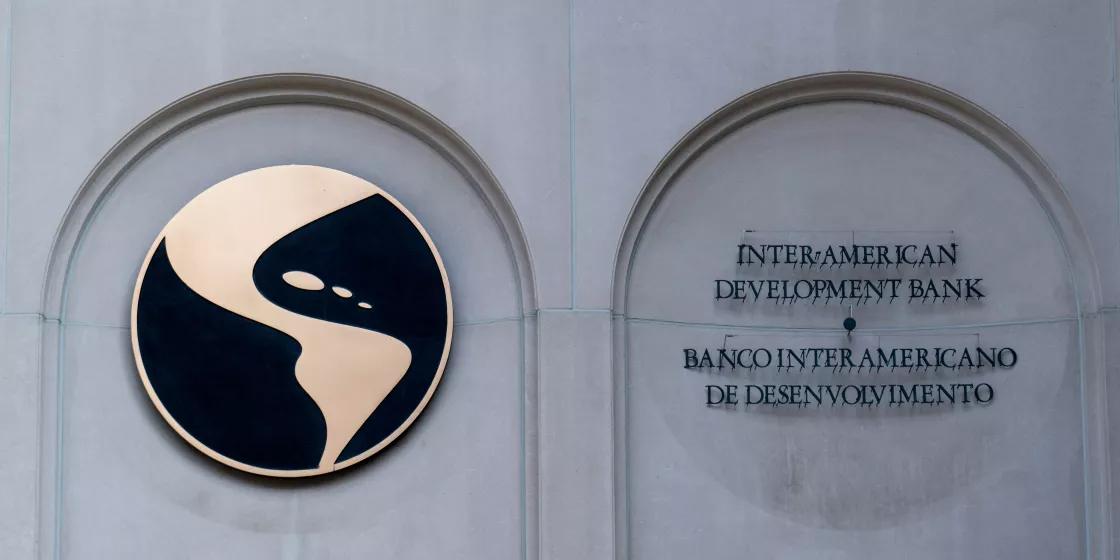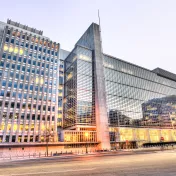A joint blog by Anja Gebel (Germanwatch), Hanna Fekete (NewClimate Institute) Imogen Outlaw (NewClimate Institute) & Laura Sabogal (E3G)
---------------------------------------------
In March 2023 the IDB Group published its “Paris Alignment Implementation Approach: Principles, Methodology, and Technical Guidance” (PAIA). The document was published on the bank’s Access to Information page without any additional public notification, which limits its accessibility. It is based on the joint MDB framework and lays out how the IDB plans to adapt the framework to its own institutional procedures.
The tone of the document is ambitious and conveys the impression that the bank is committed to the spirit of the Paris Agreement. It sets out important principles and promising steps to align the institution’s operations. The document (which is drafted for the “initial implementation phase [of Paris alignment] in 2023”) sets parameters and direction, takes stock of the current status including needs and challenges, and outlines future steps for implementation. It is complemented by “Sectorial Technical Guidance” that the IDB Group published a couple of weeks later, on the energy, transport, water/sanitation and agrifood systems sectors, as well as on its approach to financial intermediaries. The document also announces the development of further guidelines for sectors such as industry, buildings and digitalisation. However, it does not specify a clear timeline for when this will happen.
This blog post provides an overview on what are promising, concerning and unclear elements in the IDB Group’s general Paris alignment methodology, with a focus on the overall approach and some commonalities in the sectorial notes – it does not go into the details of the different sectorial technical guidance notes.
Promising parameters
The most important thing to highlight positively is the emphasis that the IDB puts on the identification of opportunities. Instead of restricting it to a risk-mitigation tool, it views PAIA as a process to help “LAC countries and businesses manage their transition to long-term carbon neutrality and climate-resilient economies”. To do so, it aims to mainstream climate in upstream policy dialogue, country strategy and programming as well as development partner coordination to promote alignment and “strategic selectivity” of operations. Climate resilience is to be fostered whenever possible (e.a.), including in operations with low physical climate risk. The IDB plans to support this crucial function of PAIA through the concept of “climate transition gaps”, i.e. obstacles to countries’ climate transition which are to be systematically gathered to inform upstream dialogue. It also explicitly foresees additional human resources, including in-country staff, for the implementation of Paris alignment. Importantly, it aims to increase ambition and climate quality of operations over time, similar to the ratcheting mechanism of the Paris Agreement. In this context it is noteworthy that the IDB takes a specific focus on just transition for the region, which it wants to combine with a long-term perspective on costs and benefits of the region’s climate transition.
Also positive is the clear reference to the 1.5°C mitigation goal of the Paris Agreement and that the IDB plans to assess projects for alignment with global and regional decarbonisation pathways to complement tests for alignment with countries’ NDCs, LTSs and NAPs. The PAIA explicitly states that projects will be assessed not only for 1.5°C alignment but also for lock-in and transition risks including stranded assets. The five assessment steps for direct investment are also applied to policy-based operations, removing an important weakness of the joint MDB approach for policy-based financing. In this context, the IDB demonstrates a broad understanding of project impacts, considering also indirect project impacts. Assessments for potential alternatives are to be conducted for all types of operations (including policy-based operations) in line with the IDB’s E&S policies – at least if highly emissive activities are under consideration.
It is also welcome that the IDB interprets and thus concretises the scope of items on the joint MDB list of universally aligned activities through more detailed lists containing the eligible types of operations, providing guidance for staff and making its decision criteria transparent. However, this does not necessarily come with stricter criteria but rather slackens ambition significantly (as in the case of road upgrading which weakens the joint MDB criterion “without capacity expansion” - see sector note on transport).
Other elements to be noted positively include the explicit planning of institutional reform steps to enable PAIA implementation, the commitment to scale up technical assistance for countries’ Paris alignment, and a clear commitment to collect lessons learned and feed them back into sector guidance, policy dialogue and support, technical assistance, market development, and country strategies. Importantly, the IDB plans to revisit and update PAIA within one year of its approval – involvement of civil society or other external stakeholders is not explicitly mentioned but the IDB’s handling of the process to date suggests there might be further opportunities for public involvement.
Aspects of concern
A major shortcoming of the PAIA is the provision that in cases where the country does not agree to adjust a misaligned project for the sake of Paris alignment, the project can still be submitted to the board together with its Paris alignment assessment (see section 2.21 of the PAIA). This means that the IDB could break its Paris alignment pledge by implementing misaligned projects after the official alignment date. Responsibility is thus transferred to the shareholders who need to ensure that non-aligned projects are not approved.
Moreover, it is lamentable that the IDB does not establish a complete exclusion of fossil fuel investments. Despite scientific evidence that new fossil fuel investments are incompatible with limiting warming to 1.5°C, the IDB does not exclude downstream and midstream oil and gas investments and, for example, considers petroleum-related investments as a back-up for isolated renewable energy and/or heating systems as well as for export during energy security crises. It will thus be highly important that it defines a robust assessment method for 1.5°C alignment, based on scientific evidence.
While the IDB’s concretisation of the joint MDB list of universally aligned activities is welcome, reliance on such a list poses a problem in itself: Projects considered part of the list do not undergo any further Paris alignment assessments. According to the IDB, about five out of six of its operations are part of the universally aligned list; this means that a major part of its operations (while avoiding the worst climate risks) will not benefit from an assessment for climate opportunities. This presents missed opportunities for mainstreaming climate-positive activities (as the IDB has set out to do), e.g. to make public administration more climate-sensitive, or to consider options for non-motorised traffic or public transport alternatives in road rehabilitation measures.
Open questions
The technical guidance entailed in the sectorial notes concretises the IDB’s understanding of Paris-aligned activities in the different sectors and facilitates the differentiation between “universally aligned” and potentially misaligned projects. However, different aspects would still merit further methodological clarification in order to be consistently and ambitiously applied by staff, such as, for example, the tools and benchmarks to determine whether operations “rely significantly on the direct utilization of fossil fuels” (restrictions to universally aligned activities) or whether they have “negligible lifecycle GHG emissions” (energy sector guidance), or whether low-GHG alternatives are “technically and economically feasible” so as to clearly delimit exceptions (transport sector guidance), among other things. It would also be interesting to know what percentage of the IDB’s portfolio will likely fall under exceptions to Paris alignment based on reasons of "differentiated capacities and responsibilities”. Regarding its approach to financial intermediaries, both technical and methodological detail is still missing. For example, it is unclear whether the counterparty approach applies to all financial intermediaries or only to those where ring-fencing of operations is not possible. It also leaves open how it will determine that the chance of a corporate counterparty undertaking non-aligned finance activities is “low” and thus negligible. The IDB does not specify any timeline for the counterparty alignment process. While foreseeing support for FIs’ capacities to transition, the IDB plans to rely on FIs’ own processes and regulatory context for assessing the alignment of transactions and hardly sets any specific standards for FIs (such as its own E&S policies, for example).
Given the explicit preliminary character of the IDB’s PAIA, important questions remain on the bank’s timeline for further implementation and complete alignment. The IDB conceives the year 2023 as the “initial” implementation phase, where priority will lie in four sectors (energy, transport, water/sanitation and agri-food systems) plus in operations with financial intermediaries. It is unclear what this means for the alignment status and timeline of IDB projects in other sectors, such as industry, buildings and digitalisation. Also, the timeline for the institutional reform steps and the provision of trainings and methodological details remains unclear. These uncertainties might in part also be related to questions of availability of corresponding resources from the shareholders’ side, as the IDB highlights that “a consistent flow of additional resources” is needed for adding capacity in terms of technical assistance and human resources. Overall, it seems that the IDB has still some way to go to ensure Paris alignment of all their projects (despite having reached its official alignment date in January 2023) and highlights the importance of revisiting the status of alignment and the methodology in one year’s time.
Similar concerns emerge from the PAIA’s proposal to have the IDB set a target for aligning operations (see section 3.2 of the PAIA). While an inclusion of incentives for Paris alignment in the bank’s Corporate Results Framework would be a welcome step to strengthen institutionalisation of Paris alignment, a target of less than 100 per cent would be a clear backsliding from its commitment to fully align by 2023.
Lastly, it would be interesting to know how the IDB plans to provide the mentioned insights on sector policies as well as on long-term evolvement of costs and benefits of climate (in)action for the client countries in the region in order to provide respective strategic proposals. For example, is the IDB planning to join forces with other MDBs, such as the World Bank, to enhance analytical capacity and ensure consistent approaches across banks? See our analysis of the World Bank's Paris alignment approach, which includes a discussion of the role that the bank’s Climate Change and Development Reports (CCDRs) can have for the Paris alignment process.
Next steps need to follow soon
Many of the principles and parameters outlined in the PAIA give rise to hope for an ambitious implementation of Paris alignment, and most of the next steps proposed sound highly promising. Now it is important that the IDB implements all of them as quickly as possible and does not slacken in the ambition set out here. Most importantly, it needs to:
- Operationalise the reform of its institutional structures and project design processes including of diagnostics and country dialogue to mainstream climate considerations in the form of both climate risks and opportunities for transformative climate action
- Develop and publish the technical guidance for the remaining sectors and specify methodological tools and benchmarks needed by staff to carry out the assessments in a consistent and effective manner, including the 1.5°C compatible pathways to be used to assess alignment
- Develop a clear timeline and implementation plan for providing human resources and trainings to enable systematic and consistent Paris alignment assessments
- Offer additional technical assistance and on-the ground expertise to countries for developing and operationalising climate-related assessments and measures
- Institutionalise the PAIA as an IDB policy to improve its official character and provide legal security, including for complainants
- Institutionalise impact monitoring and learning cycles for Paris alignment, including ratcheting mechanism for impact and standards (including on fossil fuel exclusion) as well as provisions for public consultation
If the IDB succeeds in implementing these elements in an ambitious way, it could become a real frontrunner in the MDBs’ Paris alignment process. Importantly, however, the IDB needs to make its progress on implementing its Paris alignment approach public and transparent. This means not only that it should make the current documents more easily accessible, but also includes publishing the outcomes of Paris alignment assessments and respective methods used as part of the project information as a standard procedure. Only then will it be possible for shareholders and the wider public to know whether the IDB is actually walking the talk.






